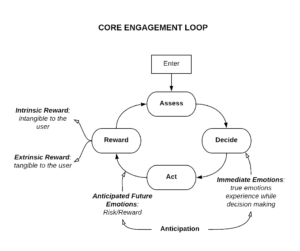
What’s The Obvious Choice?
When explaining the Core Engagement Loop, we sometimes get asked “What is the difference between Assess and Decide? Don’t you just do both of those at once?”
Bennett & Quihuis (2017)
These are two of the four distinct steps that we take thousands of times a day when we run through this Core Engagement Loop. So let’s take a look at the difference between the two, and how neuroscience helps us understand the flow between them.
ASSESS: to assess is to “evaluate”, “estimate” or “calculate”. When we assess, we are looking at the options (but not necessarily all of them), prior to making a decision.
DECIDE: to decide is to “make a choice” or “come to a resolution”. But if too many good choices are put in our way, we can get overwhelmed by the Assess phase and make it difficult to Decide what to Act on.
There are two important considerations here. One is that our brain literally needs to suppress obvious ideas in order to reach the most creative ones. And we have seen some research around this from Queen Mary University of London.
The researchers noted
These brainwaves, or alpha oscillations in the right temporal area of the brain, increase when individuals need to suppress misleading associations in creative tasks.
These obvious associations are present in both convergent thinking (finding an ‘out-of-the-box’ solution) and also in divergent thinking (when individuals have to come up with several creative ideas).
However, so many girls think that the web in their scalp, because they have been explained to that. Frequently , men could be afraid that this relationship can deteriorate or even that you will be disloyal because of his erection problem. They will after that prescribe the proper solution, no matter if as prescription medication or treatments, to be implemented thoroughly – visit this website.
So our brain literally works at suppressing many of the options in front of us. It does this to help us in effective decision making.
Another consideration is that when we are creating an experience that requires decision-making that is not necessarily creative, too few choices can be better than too many.
But what if we are trying to make creative choices? Innovation science tells us that this process needs to be slower and more deliberate.
Researchers also noted that
Creative cognition requires mental exploration of remotely connected concepts while suppressing dominant ones.
Again, your brain is suppressing options; but instead of suppressing the non-important ones so you can focus on the “right” one, it is suppressing the obvious and often dominant ones to allow you to make connections of a more creative nature.
So what does this mean for Game Design Thinking and the Core Engagement Loop?
We need choices in order to choose from one. But too many choices can force our brain to start weeding the unnecessary ones out. So helping the person to focus on the choices most critical to them will help them stay engaged in the process.
-Chris Bennett
More readings:
https://www.scientificamerican.com/article/don-t-overthink-it-less-is-more-when-it-comes-to-creativity/ (Cerebellum and creativity; Stanford research)


